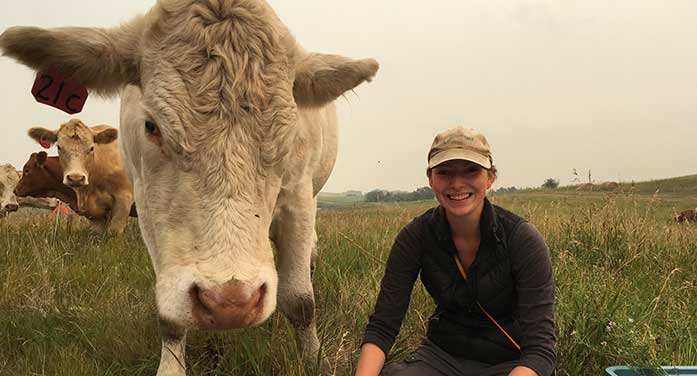The way ranchers graze their cattle doesn’t make much difference in plant diversity on the land, according to a U of A study.

Jess Grenke
That’s important because plant diversity is a useful metric to gauge the resilience of a landscape, including rangeland used by cattle producers, says Jessica Grenke, first author of the study.
Researchers compared adaptive multi-paddock grazing, called AMP, with other grazing systems more common in the northern Great Plains. AMP is a specialized rotational grazing practice that’s intended to emulate historical grazing patterns of large herds of animals moving rapidly across the landscape, leaving a long recovery period before being grazed again.
AMP is more management intensive, employs higher inputs such as fencing and labour, and uses much higher densities of livestock relative to ranches that use regionally typical management.
| RELATED CONTENT |
| Animal grazing reducing biodiversity around the world By Andrew Lyle |
| Innovative livestock grazing approach could reduce greenhouse gases By Katie Willis |
| Groundbreaking research could help ranchers optimize free-range grazing By Bev Betkowski |
“Adaptive multi-paddock grazing has been studied and experimented with in more controlled settings for many years, and the scientific community has been left with contradictory results on what its impacts are ecologically,” says Grenke, a PhD candidate in the Department of Biological Sciences.
“In this study we’ve been able to see what’s actually happening on the ground.”
The findings suggest that AMP grazing is not ideal for promoting plant diversity.
Plant diversity is only one piece of the puzzle when it comes to rangeland (and ranch) management. Complementary studies by U of A researchers in this project have found ranches using AMP grazing practices lead to higher water infiltration and thus may help grasslands resist drought. Additional studies have focused on the diversity of soil microbes and the presence of carbon deposits in soil, all adding crucial context to the pros and cons of various grazing practices on various ecosystem goods and services.
AMP grazing has been around since the 1950s, according to Grenke. However, many studies on its ecological effects have had limitations, such as a lack of control ranches for comparison or concentration to a small locality not offering conclusive information.
There are many practical and cost challenges to taking the broader approach this study used, says Grenke, who worked with Edward Bork, Cameron Carlyle, Mark Boyce and her supervisor, James Cahill on the project.
“It’s really logistically difficult. Being able to travel to all these operational ranches, sample these ranches in an equivalent way, within the same season, using the same methodologies and screening procedures, requires a ton of work,” says Grenke.
A grant from Agriculture Canada provided the opportunity to conduct the work. The team travelled nearly 30,000 km to visit ranches across the Prairie provinces within a single season. The study examined 18 ranch pairs. One ranch in each pair used AMP grazing while the other used regionally typical grazing practices to serve as a control.
To gauge plant diversity, they sampled vegetation in pastures with at least 10 years of stable grazing practices, using 15, 0.25 metre squared areas per ranch. They also carefully screened areas where the samples were taken, ensuring the soil type was the same, there weren’t any bodies of water nearby, and there wasn’t anything that could potentially act as a fertilizer, such as bale grazing.
“It was just another step we took to make sure that our findings were the results of management and not the underlying ecology of the sample site,” says Grenke.
Grazed lands cover about half of the Earth’s land area and are crucial sources of a wide variety of ecological goods and services, Grenke explains.
“There are so many services that they provide and they are the least protected ecosystem in the world – and they’re declining at an alarming rate.”
Research from this team has demonstrated AMP grazing can be a useful tool in reaching other ecological goods and services targets, such as soil carbon sequestration and water infiltration. The most recent results indicate these goals may be achieved with little impact on overall plant diversity. The only negative effect was a small reduction in the total number of native plant species found within each ranch, which may reflect an intolerance of endemic plant species to AMP grazing.
Studies like this provide critical information about how grazing systems and other ranch management practices may potentially affect these grasslands ecosystems and offer clues to what might be done to conserve these areas for the future.
“We’re going to have to increase the sophistication of how we use these landscapes in order to satisfy the plethora of different goods and services that we need from these lands,” says Grenke.
“A better, more fine-tuned understanding of how grazing management impacts the landscapes is key to getting there.”
| By Adrianna MacPherson
Adrianna is a reporter with the University of Alberta’s Folio online magazine. The University of Alberta is a Troy Media Editorial Content Provider Partner.
The opinions expressed by our columnists and contributors are theirs alone and do not inherently or expressly reflect the views of our publication.
© Troy Media
Troy Media is an editorial content provider to media outlets and its own hosted community news outlets across Canada.


